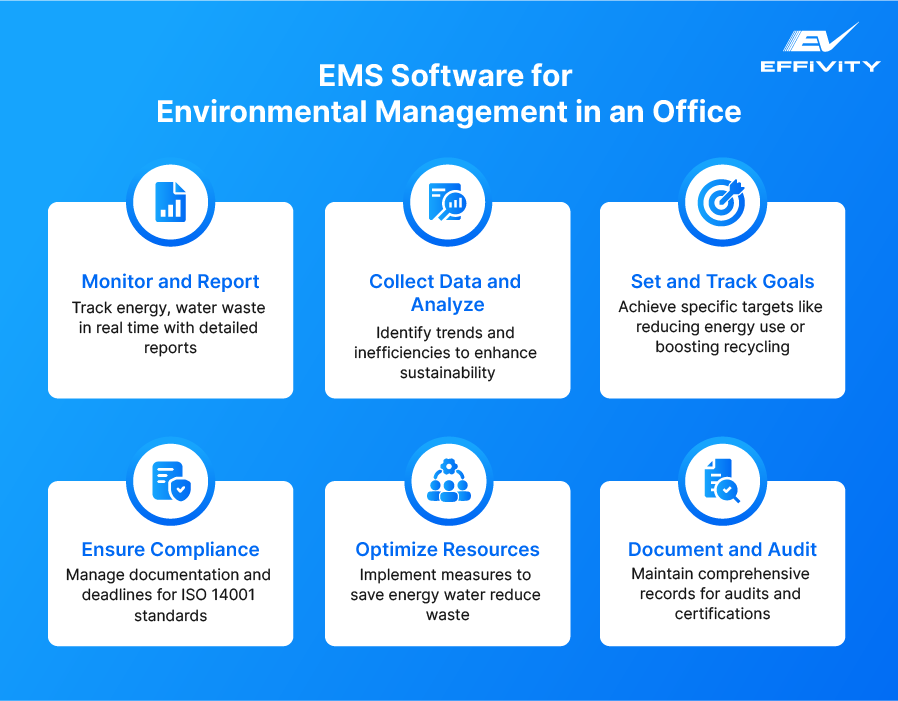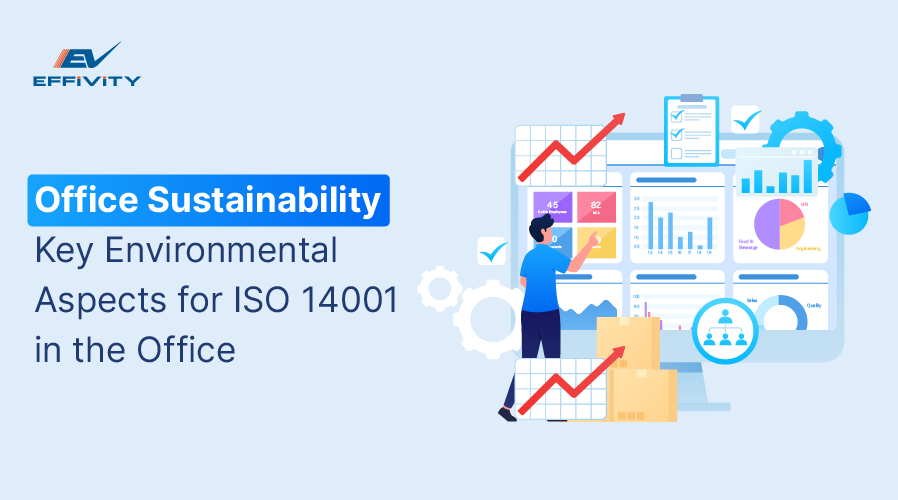Imagine you run a factory. You would notice emissions, waste production energy consumption and how these can affect the environment. In such a case, you would know exactly what environmental aspects you must look into and manage to maintain ISO 14001 compliance.
However, if you are in an office setting, where there are no heavy machinery emissions, hazardous waste, or significant resource consumption, are there still environmental aspects you should be concerned about? Offices are generally perceived as having a low environmental impact, which means employees and stakeholders are likely to be less aware of environmental aspects.
In this article, we address the common misconception that office activities do not significantly impact the environment. We will look at the most common environmental aspects in the office setting and how you can manage these using Environmental Management System software to maintain ISO 14001 environmental compliance.
What are Environmental Aspects According to ISO 14001?
According to ISO 14001, environmental aspects are elements of your daily activities that can interact with the environment. You might not realize it, but every action in your office, from energy use to waste production, can impact the environment.
You need to consider both direct and indirect environmental aspects. Direct aspects might include the electricity you use for lighting and computers or the paper waste from printing. Indirect aspects could involve the environmental policies of your suppliers or the carbon footprint of employee commuting.
Implementing ISO 14001 involves assessing these aspects and determining their significance. You then establish objectives and controls to mitigate negative impacts. Using Environmental Management System software helps you track and manage your environmental aspects, ensuring you meet ISO 14001 standards.
What are the Environmental Aspects in the Office Setting?
Environmental aspects exist in office spaces and are related to your organization's activities, products and services. Understanding these aspects helps you identify areas where you can reduce your environmental impact.
1. Energy Consumption
You use energy daily for lighting, heating, cooling and powering electronic devices. Simple actions like using energy-efficient bulbs, turning off devices when not in use and managing heating and cooling systems can reduce your office's energy consumption significantly. Reducing energy usage lowers your environment and saves on utility bills.
2. Waste Management
Offices generate various types of waste, including paper, plastic and electronic waste. Implementing recycling programs and reducing single-use items can make a big difference. You can encourage employees to minimize waste by providing recycling bins and promoting a culture of sustainability.
3. Water Usage
Even in an office, water usage is an important aspect to monitor. You can install low-flow faucets, toilets and other facilities to conserve water. Encouraging employees to report leaks and being mindful of water usage in kitchens and restrooms helps in reducing unnecessary water consumption.
4. Paper Consumption
Paper consumption remains high in many offices. You can switch to digital documentation and use double-sided printing to cut down on paper use. Encouraging the use of digital tools and reducing unnecessary printing helps conserve trees and reduce waste.
5. Transportation
Employee commuting and business travel contribute to your office's carbon footprint. Promoting remote work, carpooling the use of public transportation can reduce this impact. Encouraging virtual meetings instead of travel for business purposes also helps. Managing transportation aspects lowers greenhouse gas emissions and promotes a greener office culture.
6. Chemical Usage
Offices use various chemicals in cleaning products and maintenance supplies. Opting for eco-friendly and non-toxic products minimizes harmful environmental impacts. Ensuring proper storage and disposal of chemicals is crucial. By choosing green cleaning products, you create a healthier workplace and reduce your office's environmental footprint.
7. Office Supplies
The procurement and disposal of office supplies, like toner cartridges and batteries, can impact the environment. Choose sustainable products and suppliers committed to environmental practices. Encouraging the reuse and recycling of office supplies can also make a significant difference. Managing office supplies responsibly supports overall sustainability efforts and reduces waste.
How to Manage Environmental Aspects?
Using EMS software helps you manage environmental aspects efficiently. Here's how it helps streamline your office's sustainability efforts:

1. Monitor and Report
EMS software allows you to monitor energy usage, water consumption and waste management in real time. You can generate detailed reports to track progress and identify areas for improvement. Regularly tracking your sustainability efforts ensures you stay on top of your environmental performance.
2. Collect Data and Analyze
The software collects data on various environmental aspects like energy and paper usage. It analyzes this data to identify patterns and inefficiencies. By understanding these trends, you can make informed decisions to enhance your sustainability efforts.
3. Goal Setting, Tracking Communication
EMS software lets you set specific environmental goals, such as reducing energy usage or increasing recycling rates. It tracks progress and provides updates, helping you stay put on your strategic EMS plans. Clear communication of these goals and achievements fosters a culture of sustainability in the office.
4. Manage Compliance
Staying compliant with environmental regulations is crucial. EMS software helps manage documentation, deadlines and reporting requirements. It ensures all necessary compliance measures are in place, keeping your office in line with ISO 14001 compliance standards.
5. Manage Resource
Optimize resource usage with EMS software by implementing energy-saving measures, water conservation practices and waste reduction strategies. The software helps you manage resources efficiently, save resources and reduce your environmental footprint.
6. Document and Audit
EMS software maintains comprehensive records of all environmental activities and initiatives. This documentation is vital for audits and certifications. It ensures transparency and accountability, demonstrating your office's commitment to sustainability.
Final Thoughts
Managing environmental aspects in an office setting is crucial for maintaining ISO 14001 compliance. It goes beyond simply meeting regulations as it enhances your office's overall sustainability. By understanding and finding solutions for these aspects, you can reduce your environmental impact.
Using EMS software makes this process more efficient and effective. It helps you monitor, analyze, manage environmental data, setting and tracking goals while ensuring compliance with environmental standards. This systematic approach supports sustainability and improves operational procedures and efficiency.
Additionally, a strong focus on environmental management boosts your social standing. Stakeholders and customers increasingly value sustainability efforts. Demonstrating a commitment to environmental responsibility through the use of EMS software positions your office as a leader in sustainability, fostering trust and respect in the community.






























